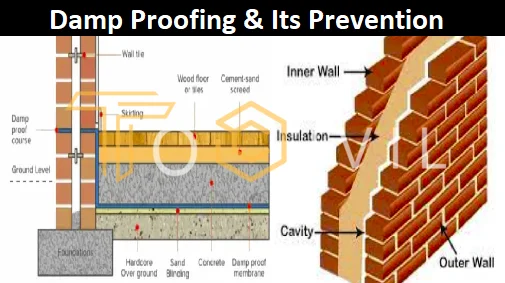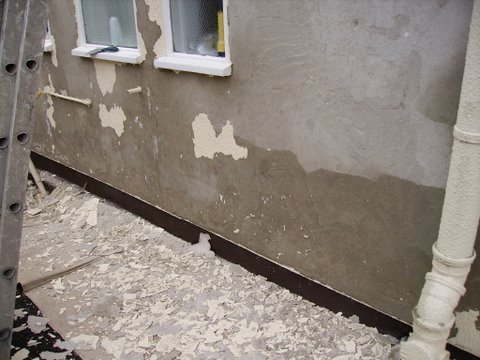Must-have equipment damp specialist newcastle uses during inspection
Exploring the Different Methods and Solutions for Effective Damp Proofing
Moisture in buildings presents significant difficulties to both structural integrity and interior air top quality. Various methods and remedies have arised to battle this pervasive issue. From conventional damp-proof membranes to ingenious chemical treatments, each approach provides one-of-a-kind advantages. Understanding these choices is necessary for reliable moisture control. Nevertheless, picking the right remedy depends upon certain structure conditions and needs, prompting additional exploration right into the most reliable wet proofing strategies offered.
Understanding the Reasons For Wetness
Although moisture can occur from various sources, recognizing these reasons is important for reliable remediation. Commonly, moisture stems from three key sources: rising moist, penetrating damp, and condensation. Climbing damp takes place when groundwater travels upwards with porous products, such as block or rock, commonly because of an absence of an effective obstacle (damp removal newcastle). Passing through moist is usually triggered by external elements, consisting of roof leakages, damaged rain gutters, or damaged walls, enabling water to penetrate a residential property. Condensation, on the other hand, results from excess wetness in the air, typically exacerbated by inadequate air flow and temperature differences, causing water droplets basing on surfaces. Identifying these underlying issues is essential, as each kind of dampness calls for a tailored method for remediation. Proper assessment aids in figuring out one of the most efficient options, inevitably safeguarding the structural integrity of a building and enhancing interior air high quality
Typical Damp-Proof Membranes

Chemical Damp-Proofing Solutions
Chemical damp-proofing remedies offer an ingenious strategy to avoid moisture intrusion in structures. These methods typically involve the application of fluid chemicals that pass through stonework and form an obstacle against increasing damp. Commonly made use of chemicals include silanes, siloxanes, and various other water-repellent representatives that react with surface materials to develop a hydrophobic layer.The application process usually calls for exploration holes into the walls, infusing the chemical service, and allowing it to cure. This technique is specifically useful for older structures where traditional damp-proof membrane layers may be not practical. Chemical damp-proofing can be less disruptive and a lot more cost-efficient than substantial remodelling projects.While efficient, these services depend on correct application and environmental conditions for peak efficiency. damp proofing newcastle. Regular maintenance and tracking are vital to guarantee the longevity of the damp-proofing therapy. Overall, chemical damp-proofing stands for a functional option for protecting buildings versus moisture-related damage
Tooth Cavity Wall Construction Strategies
Tooth cavity wall surface building methods supply numerous advantages, particularly in wetness control and power performance. By integrating an air gap in between 2 layers of masonry, these walls efficiently alleviate water ingress while enhancing insulation. This mix not just safeguards structures from dampness however also adds to decreased power usage.
Advantages of Cavity Walls
When considering reliable damp proofing approaches, the benefits of cavity wall surfaces stand apart plainly. Cavity wall surfaces contain 2 different layers, developing an air space that successfully reduces dampness infiltration. This layout reduces the danger of moisture, as the outer wall surface acts as an obstacle against rainfall and water ingress. Additionally, tooth cavity wall surfaces improve thermal insulation, which adds to energy performance by decreasing warm loss. They additionally give sound insulation, assisting to produce a quieter interior environment. The air gap allows for ventilation, which assists in dampness control and decreases the chance of mold and mildew growth. These advantages not only boost the general comfort of a structure but likewise add to its durability and structural integrity.
Wetness Control Approaches
Efficient moisture control methods are crucial in dental caries wall surface building and construction to assure lasting protection against dampness. One main method includes the incorporation of weep openings, which facilitate water drain from the tooth cavity, stopping build-up. Additionally, the use of breathable membranes can aid handle dampness levels while permitting entraped vapor to leave. Correct placement of insulation is also critical, as it should not block water drainage paths. Additionally, making certain that the external fallen leaves of the cavity wall surface are constructed with waterproof products boosts general sturdiness. Regular upkeep checks are necessary to recognize any type of clogs or damages early, guarding the framework's stability. Inevitably, a mix of these strategies develops a robust protection against dampness invasion in dental caries walls.
Insulation and Power Efficiency
Insulation plays an important role in enhancing power performance within tooth cavity wall surface building. By integrating shielding materials, these walls develop a thermal barrier that decreases warmth loss and reduces power intake. Reliable insulation not only aids keep a steady indoor temperature yet additionally mitigates the threat of moisture, as it avoids condensation within the wall surface tooth cavity. Numerous strategies, such as making use of stiff foam boards or mineral woollen, can be used to achieve optimal insulation efficiency. Furthermore, click here appropriate setup is important to guarantee that voids and gaps are lessened, which can or else jeopardize power effectiveness. Inevitably, a well-insulated dental caries wall surface adds greatly to general sustainability and reduces heating & cooling expenses for home owners.
External Damp Proofing Methods
External wet proofing methods are crucial for shielding frameworks from wetness seepage. Two reliable techniques include the application of waterproof membrane layers and the installment of French drains pipes. These services help minimize water build-up and preserve the stability of structures.
Waterproof Membrane Application
While different methods exist for protecting against moisture access, the application of water resistant membranes remains a very efficient exterior damp proofing method. These membrane layers are normally made from products such as polyethylene, rubber, or changed asphalt, offering a robust obstacle against water infiltration. The installation process involves applying the membrane layer to the exterior surfaces of wall surfaces or foundations, making sure full protection to avoid leaks. Appropriate attachment and securing at joints are crucial to taking full advantage of effectiveness. Water resistant membranes can be applied in various kinds, consisting of liquid finishings and sheet membrane layers, enabling flexibility based upon the specific requirements of the framework. This method not just protects structures from moisture yet likewise improves their durability and structural integrity.
French Drain Installation
One effective method for taking care of groundwater and preventing dampness build-up around a building's structure is the installment of a French drainpipe. This water drainage system contains a trench loaded with gravel and a perforated pipe that reroutes surface area water far from the foundation. Appropriate setup calls for cautious planning, making sure that the drainpipe inclines far from the framework to assist in suitable water circulation. Furthermore, the place of the drain is crucial; it should be positioned in locations susceptible to merging or excess moisture. Routine upkeep, consisting of clearing up particles from the gravel and making sure the pipe stays unhampered, is vital for lasting performance. Eventually, a well-installed French drain can significantly minimize the risk of water-related concerns in structures and basements.
Inside Waterproofing Approaches
Interior waterproofing approaches are important for safeguarding a structure's interior from dampness seepage and prospective water damage. These strategies generally involve the application of customized materials and techniques designed to create a moisture barrier within the structure. One common approach is making use of waterproof coverings or sealers on walls and floors, which avoid wetness from passing through surfaces.Additionally, installing indoor water drainage systems, such as sump pumps, can successfully manage water build-up in cellars and creep areas. Another technique includes using vapor obstacles, which are mounted to inhibit moisture movement from the ground right into living spaces.Moreover, addressing any fractures or spaces in walls or structures with ideal sealants guarantees a thorough defense against water invasion. By carrying out these indoor waterproofing techniques, homeowner can greatly minimize the risk of mold and mildew growth, architectural damages, and other moisture-related issues. Proper implementation of these techniques is necessary for long-lasting protection and building integrity.
Routine Upkeep and Evaluation Practices
Regular upkeep and examination methods are important for guaranteeing the lasting effectiveness of wet proofing remedies in any kind of building. Routine checks enable building proprietors to recognize early signs of wetness intrusion, such as peeling off paint, mold growth, and stuffy smells. These indications can indicate underlying concerns that call for prompt attention.Inspections should be performed at the very least each year, concentrating on prone locations like basements, creep rooms, and exterior walls. During these analyses, property proprietors ought to take a look at sealers, water drainage systems, and air flow to validate they operate correctly.Additionally, keeping downspouts and gutters is crucial, as clogged up systems can bring about water build-up near the structure. Carrying out a routine upkeep schedule, in addition to timely repair services, can substantially extend the lifespan of wet proofing procedures and secure the architectural honesty of the structure. Positive steps ultimately add to the total health and wellness of the living atmosphere.
Frequently Asked Concerns
The Length Of Time Does Damp Proofing Commonly Last?
The duration of moist proofing effectiveness varies, normally lasting between 20 to half a century. Elements such as application quality, environmental conditions, and maintenance practices substantially affect the longevity of the damp proofing treatment.

Can I Damp Evidence My Home Myself?
The individual considered the expediency of do it yourself damp proofing. With proper research and the best products, it is possible. They likewise identified the importance of specialist assistance to guarantee durable effectiveness and protect against future issues.
What Are the Signs of Ineffective Damp Proofing?
Signs of ineffective wet proofing consist of relentless stuffy smells, noticeable mold and mildew development, peeling paint, damp spots on walls, and wood degeneration - mould removal newcastle. Homeowners must address these concerns without delay to avoid further damage and health and wellness issues
Does Damp Proofing Affect Indoor Air Top Quality?

Just How Much Does Expert Damp Proofing Price?
Professional moist proofing costs differ substantially, commonly varying from $1,000 to $5,000 relying on the residential or commercial property's dimension, the degree of the damp issue, and picked techniques. Each circumstance requires a tailored evaluation for precise prices. Commonly, moisture stems from 3 key sources: climbing damp, permeating damp, and condensation. When considering reliable moist proofing approaches, the benefits of cavity walls stand out plainly. External damp proofing approaches are essential for securing structures from wetness infiltration. While numerous techniques exist for protecting against wetness ingress, the application of water resistant membrane layers stays an extremely effective external damp proofing technique. Signs of inadequate damp proofing consist of persistent musty odors, visible mold growth, peeling paint, damp spots on walls, and wood decay.